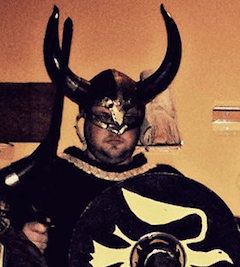 I laugh when my Facebook feed advertises some inspirational book or other called The Way of the Viking or something like that – I imagine its probable romantic perspective – the usual “be strong and tough and persistent and good things will come to you” line, packaged this time under the image of a figure part historical and part the product of fanciful romance. I laugh because the mysterious Facebook algorithms are trying to pitch it to me who, in spite of possessing a Viking patronymic calcified by some unknown son of Per, would probably not survive the Viking age – asthmatic unfit me – Sam Tarly amidst the Vikings.
I laugh when my Facebook feed advertises some inspirational book or other called The Way of the Viking or something like that – I imagine its probable romantic perspective – the usual “be strong and tough and persistent and good things will come to you” line, packaged this time under the image of a figure part historical and part the product of fanciful romance. I laugh because the mysterious Facebook algorithms are trying to pitch it to me who, in spite of possessing a Viking patronymic calcified by some unknown son of Per, would probably not survive the Viking age – asthmatic unfit me – Sam Tarly amidst the Vikings.
And yet there is something that also draws me – not so much to the image of rough and inspirational manly men, but certainly to much of the Viking mythopoeia that hovers between imagination and history. There is a part of me that really does understand, if in a rather silly kind of way, what the folks from Gimli (New Iceland, where numerous Icelanders settled in Manitoba) like to say –
It may be true that Viking warriors didn’t wear horned helmets, but if they had had any proper sense of fashion, they would have.
There is also something more serious in me, drawn to the quality that mentors such as C. S. Lewis and J. R. R Tolkien have called Northerness – friendships and longing forged amidst a loneliness set in battle against a chaos that will eventually overthrow even the gods. Yet if this spirit can be nourishing, it can also be perilous.
For if it can, as in the cases of a Lewis or a Tolkien, serve as a protoevangelion, it can also, if the scales tip another way, become something callous and nihilistic. If Beowulf can, as Tolkien notes, contain “a theme no Christian need despise” (“The Monsters and the Critics”), there is also some truth in Chesterton who, though not an Anglo-Saxonist, nonetheless astutely captures in The Ballad of the White Horse a certain kind of nihilistic spirit also at work in Nordic culture; Ogier the Dane in Book III celebrates “the wrath of the gods behind the gods/who would rend all gods and men,” and concludes that “hate alone is true.” One can discern something of a through-line from the chilling childhood violence of Egil Skallagrímson in the saga named after him – praised by his mother for murdering another child on the sports field – to the violence at the heart of modern Nordic mystery narratives such as Wallander and The Girl with the Dragon Tattoo.
There is something problematic when the commendably black and flat sense of humour loses its empathy and becomes callous laughter at the pain of others – which in fact it can become in certain death-metal cultures and white supremacist groups.
“From the fury of the Northmen, good lord deliver us,” goes the unattested line apocryphally attributed to a Christian litany during the Viking age – and as someone with Scandinavian heritage I can understand this prayer just as much as I can appreciate the beauty of my heritage. There is probably nothing more beautiful to me than fighting and loving alongside friends on the losing side – this is a gift that Viking culture offers for baptism into Christianity, as in the cases of Christians such as Lewis and Tolkien.
However, there is also nothing more frightening than discerning in oneself the potential berserker, the warrior who flies into a battle trance killing friend and foe alike – all that gets in his or her way. There is nothing like fearing that something in you might snap and – though the effect might perhaps be less physical than it was in ages past – turn all of one’s powers toward the destruction and obliteration of one’s apparent opponents regardless of truth or right – a frightening thing indeed when one has twelve-plus years of post-secondary education and a set of degrees in rhetorical jousting.
People often wonder why I have chosen to be part of a Church with so many limits and boundaries and rules – they would not wonder this if they saw me as unmoored as I sometimes feel. People often idealize freedom – but the Viking has seen the fear that lies just beyond the edge of freedom. The romantic who has never really been traveling idealizes freedom and very often along with it chaos. But the Viking who knows the taste of these things prefers the mead hall instead – the “freedom” of encountering chaos is not a thing to covet.
To be sure, I am here indulging in a bit of mythopoeic cosplay-writing as a member of a people group that exists halfway between imaginary legend and documentable history. As a scholar, I realize the perils of this from a strictly historicist perspective – myths and legends and reality get all mixed together, and before we know it we end up with horned Viking helmets and the idea that the term “Viking” refers to Nordic culture generally rather than a particular set of technologically advanced mariners who lived within a particular and fixed time-period. Further, as one who knows spiritual battle, I am keenly aware of and worried about some of the darker edges of the mythopoeic setting – it is deeply grievous to me that one of my texts, Beowulf, has been appropriated as a “classical Aryan” text by a certain kind of white supremacist.
And yet…and yet…there is also a part of me that wonders about the possibility of recovery and wonder. I wonder with my neighbours from Gimli if some of the more fictive additions to the Viking mythology in later times, though perhaps not true, might in fact not still be considered as part of the spirit of the thing. And I wonder further – with the Inklings – whether something might not be redeemed here.
Yes, there are those interested on account of darkness and a certain kind of Wagnerian racism. But for all that there are also those like Tolkien who carefully wrested these mythologies from more indelicate hands – or those like Lewis who gave a secret lecture for MI6 on Icelandic sagas, presumably to pre-empt any potential these might have of falling prey to Nazi appropriation.
And so it is that I have volunteered to be Sick Pilgrim’s official Viking Correspondent. Posting will not be regular, but sporadic – for the point of the Viking is to hide in the bay, or vik, and surprise you when you least expect him. You won’t see me coming.
What you can expect, though, is a half-serious, half-humorous correspondence from out of the curiously illuminated darkness of Nordic culture. Some posts will be on the more sober side – treating for instance Ragnar Bragason’s film Málmhaus and its representation of Norse death-metal culture as a troubling yet also quasi-sacramental way of dealing with grief. Others will be more humorous, such as the account of The Long Ships’ Red Orm and his plan to get his guests stone drunk under the table so he can baptize them and make them Christians (the priest is not so sure this is a good plan), or my grandfather’s traditional method of fish-hook removal when it’s embedded in the flesh (it’s as straightforward as you think it is, and it hurts – but it’s quick…). Some posts might be historical – such as a reflection on the general Nordic shift from Catholicism to Lutheranism – and others might be plain weird from a North American perspective – such as a reflection on the hot pot culture of Iceland. Whatever it is, you probably won’t see it coming – just like the Viking hiding out in Sick Pilgrim’s neighbourhood bay.













